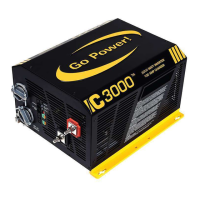gpelectric.com | [page 19]
3.5 DC WIRING
The cables linking the Inverter/Charger to the battery bank are the DC cables. These cables handle the Direct Current power
used to charge the batteries (Charging Mode) and power the main appliances (Inverter Mode). It is important to select the correct
wire size and to provide adequate over-current protection between the Inverter/Charger and battery bank.
INSTALLATION
The following points must be observed for the DC Wiring.
•
The DC positive and negative cables connected to the Inverter/Charger from the battery bank should be linked
together with zip ties or electrical tape every 6” (15cm). This helps to reduce radio frequency interference and
reducestheeectsofinductance,bothofwhichimprovetheInverter/Chargerwaveformandreducethewearof
theltercapacitors.
•
To ensure optimum Inverter/Charger performance, the number of connections between the battery bank and
the Inverter/Charger unit should be minimized except from the over-current and battery disconnect devices. All
additional connection points will cause extra voltage drops.
• The Battery bank voltage must match the DC voltage required by the IC Series, which is 12V. Do not connect a
24V battery bank to the Inverter/Charger.
•
All DC cable wire terminations should use crimped and sealed copper ring terminal lugs. Lugs with an 8mm (5/16”)
hole should be used to connect the DC cables to the Inverter/Charger’s DC terminals.
• Make sure all cables have a smooth bend radius and no kinks are present.
•
Colour code all DC Cables coming to/from the battery bank. Use colored electrical tape or heat shrink tubing.
Red for positive (+), Black for negative (-), and Green for DC ground.
NOTE: Properly rated bus bars and battery disconnects are recommended but not required..
IC Series Inverter/Charger
Earth Ground (RV, Boat Ground)
Equipment Grounding Bus Bar
Battery Disconnect Switch
(not required if circuit breaker is used)
6v
6v 6v
6v

